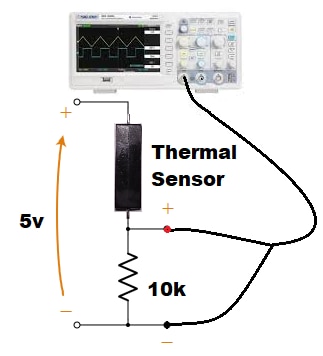Table of Contents
- Project Introduction
- Testing the OHD1-50B Thermal Sensor
- Testing the OHD1-50B and M-TRS5-60B Thermal Sensors
- Detecting Transition From ON to OFF on Thermal Sensors
- Activation of a Fan with a OHD1-30B Thermal Sensor
- Cutting Power to the 3D Printer when Thermal Sensor Detects Thermal Runaway
- Project Report Updated
**********************************************************************************************************************
Detecting Transition From ON to OFF on Thermal Sensors
As part of the discussion I had in my blog number 2, the idea of investigating the transition from ON to OFF in thermal sensors came up. This is important since it gives us an idea of the response speed of the thermal sensors and if this transition is clean.
Update: At the end of this post I compare the transition from ON to OFF between a thermal sensor and a relay.
OHD1-50B Thermal
First we will sample the signal through an ADC port of an Arduino board and see the data flowing through the serial port, and then we will see it through the serial plotter. The code used is simple and I uploaded it on an Arduino MEGA 2560 board but you can use any Arduino board, I will show you the code below.
Test_ADC.ino
int analogPin = A3; // potentiometer wiper (middle terminal) connected to analog pin 3
// outside leads to ground and +5V
int val = 0; // variable to store the value read
void setup() {
Serial.begin(9600); // setup serial
}
void loop() {
val = analogRead(analogPin); // read the input pin
Serial.println(val); // debug value
}
In the video below you can see the test done.
You can see the transition between ON and OFF, but it is still not clear to us how clean the signal is since the Arduino IDE has a lot of noise. The solution is to observe the signal through a digital oscilloscope since this can capture the signal at the moment of the transition, only it´s necessary to experiment with the data that is entered into the oscilloscope. Next I show you the experiment that I did.

As you can see, it's possible to see a transition of the signal from ON to OFF with the digital oscilloscope. In addition, this signal is clean and occurs in a time interval of approximately 200 microseconds. In the image below I show you a screenshot.
MTRS5-60B Thermal Sensor
Now I just have to check if this transition occurs in all thermal sensors, for this reason we repeat the experiment with the MTRS5-60B Thermal Sensor and this is what I observed using Arduino IDE.
I also repeated the test with the digital oscilloscope and this is what I saw.
The signal behaves in a similar way in all the thermal sensors, below I show you an image captured with the digital oscilloscope.
Grove-Relay
I have repeated the same experiment but with a relay and the objective is to compare its transition behavior with the thermal sensors. Below I show you the video.
The relay signal behaves in a similar way with to thermal sensors,as we can see in the image captured with a digital oscilloscope.
Conclusion
- Transition signal of a thermal sensor: a signal of 500 mv drops to approx. 40 mv abruptly. In the end, the signal falls linearly from 40 mv to 0 mv in approximately 150 microseconds.
- Transition signal of a mechanical relay: a signal of 150 mv drops to approx. 50 mv abruptly. In the end, exponentially the signal falls from 50 mv to 0 mv in approx. 220 microseconds.
- The thermal sensors signal behaves in a similar way with a relay, as we can see in the images captured with a digital oscilloscope. However, I see a slightly faster and cleaner response in the thermal sensor.
